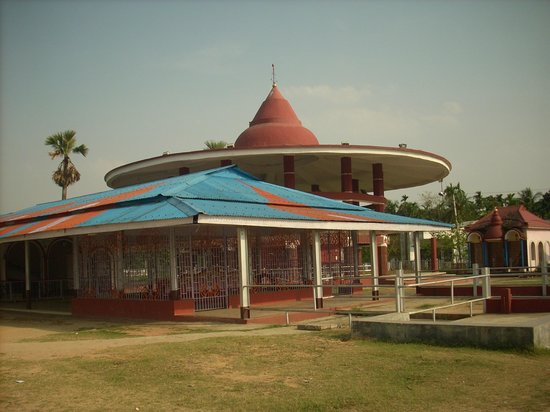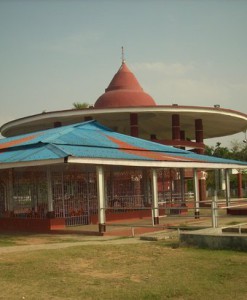No products in the cart.
Chaturdasha Temple, Tripura
The Chaturdasha Temple of Tripura or the Temple Of Fourteen Deities is located near the old part of Agartala where the royal palace is situated. The location of the temple is about 8 kilometers away from the main city of Agartala which is the capital of the state of Tripura in India. The temple was dedicated to the “Chaturdasha Devata” which means fourteen deities. The temple was built by King Krishna Manikya Debbarma who was the ruler of Tripura at that time.
The temple is fondly called the Chaudda Devata Mandir. The fourteen deities worshipped at the Chaturdasha temple Tripura are called Burasa, Lampra, Bikhatra, Akhatra, Thumnairok, Sangroma, Bonirok, Twima, Songram, Mwtaikotor, Mailuma, Noksumwtai, Swkalmwtai and Khuluma in Kokborok. These deities are the local forms of Hindu Gods and Goddesses who are Brahma, Vishnu, Shiva, Durga, Lakshmi, Kartikeya, Saraswati, Ganesha, Samudra, Prithvi, Agni, Ganga, Himadri and Kamadeva respectively. These deities and the Gods represented here have completely influenced the people of this state which is called the Country of Fourteen Gods and Goddesses. People from the neighboring states also come here in large numbers every year to pray for peace, happiness and prosperity.
All fourteen are the presiding deities of this temple as they are the Gods and Goddesses that were originally worshipped by the royal family of Tripura. The ritual of worshipping all of them together has been handed down from the days when kings used to rule this region. Each of them represents a God or Goddess who is very important in the Hindu religion and therefore, they all have equal stature as far as the worship at the temple is concerned and are worshipped with equal reverence during the festivals. The idols were originally tribal but were later inducted into Hindu customs. The typical characteristics of the idols that distinguish them from other temples are their form that signifies tribal influence. The deities are worshipped in the form of heads only i.e. none of the idols have any trunk with hands and legs. The formations of the idols start from the shoulder upwards up to the crowns that sit on the top of their heads. The idols are made of alloy except one which is made of silver. This idol is of Lord Shiva.
The fourteen deities make up the main attractions of the temple. The king of Tripura had started worshipping only these fourteen deities. The custom of worshipping only these fourteen Gods and Goddesses has been prevalent for a long time, and there is no other God that the people of this region worship. It is for this reason that there are no other shrines in the vicinity of this temple.
Tripura is called the land of the fourteen Gods. As per legend and the description in the royal chronicles regarding Chaturdasha temple history, king Tripur was killed by Lord Shiva because of his irreligious acts and conduct. Harabati, the widow of Tripur, had gone to bathe in the river when she saw the fourteen Gods being chased by a wild buffalo and taking refuge on a cotton tree. Harbati helped the gods to kill the wild buffalo and save themselves. The fourteen gods and goddesses were so pleased with Harabati that they came to stay in the royal palace at Udaipur and were worshipped there. The sacrifice of a wild buffalo at the Kharchi festival has come down as a tradition since then.
The city of Udaipur fell to Muslim invaders under the command of Samser Gaji. The Muslim invaders occupied the city, and the Tripuri king had to shift his capital to Agartala on the banks of the river Haora. It is said that when King Krishna Manikya Debbarma set up a new capital at Agartala after leaving his original capital Udaipur behind, the gods and goddesses also wanted to leave the place and come with him to his new adobe. The king took their request to heart and brought them to Agartala and installed them at the newly built temple.
The King installed the heads of the fourteen deities he had worshipped in Udaipur. All idols were originally made of alloy. When one of the heads got washed away while being bathed in the river, it was replaced by a head made of silver. The temple that he had built for the fourteen deities had a flat roof that was similar to the architecture followed in Bengal at that time but has two domes that taper upwards like Buddhist stupas. The one at the back is higher than the one at the front.
All fourteen are the presiding deities of this temple as they were the gods and goddesses that were originally worshipped by the royal family of Tripura. The ritual of worshipping all of them together has been handed down from the days when kings used to rule this region. Each of them represents a god or goddess who is very important in the Hindu religion. They all have equal stature as far as the worship at the temple is concerned and are worshipped with equal reverence and together during the festivals.
The idols were originally tribal but were later inducted into Hindu customs. The typical characteristics of the idols that distinguish them from other temples are their form that signifies tribal influence. The deities are worshipped in the form of heads only i.e. none of the idols have any trunk with hands and legs. The formations of the idols start from the shoulder upwards up to the crowns that sit on the top of their heads. The idols are made of alloy except one which is made of silver. This idol is of Lord Shiva.
The fourteen deities make up the main attractions of the temple. The king of Tripura had started worshipping only these fourteen deities. The custom of worshipping only these fourteen gods and goddesses have been prevalent for a long time, and there is no other God that the people of this region worship. It is this reason there are no other shrines in the vicinity of this temple.
The images present in the temple represent only the heads of the gods and goddesses worshiped. It is only during Karachi Puja that all the fourteen gods are brought in the open for devotion in public. Thousands of pilgrims and devotees from tribal and non-tribal communities visit this place during festival. The temple consists of a Nat Mandapa and Garbhagriha.
The roof of the temple is flat, on which rise two tapering domes, the upper one stepped slightly behind the lower one. The top of the dome is crowned with Kalasa (pitcher) including Pataka (flag).
The person who performs the worship of these deities in the temple is called Chantai or head priest among the Tripuri priests. The most important puja is the Kharchi puja when the idols are brought out into the open from the temple. All the deities are placed in a row facing the area of the mandapam when the puja is performed. It allows the people gathered in the temple to see the puja being performed by the head priest. Thousands of devotees from all over the state and outside the state visit this temple during this puja to pay their respects to the gods and goddesses and pray to them.
The Kharchi Puja is an amalgamation of Hindu and Kokborok customs. The main festival of Kharchi falls in the month of Ashada, which falls between June and July. It is the rainy season in the area signified by the month which means the same. The festival stretches over seven days. On the day before the festival starts the priests perform the Jari puja. During this puja goats in large numbers and buffaloes are sacrificed to appease the gods and goddesses. Before the actual puja begins, the deities of Uma, Hari, Maa, Hara, Kumar, Bani, Brahma, Ganesh, Samudra, Ganga, Prithvi, Kamesh, Abdi, and Himadri are taken for holy bath in the river Haora. After the holy bath, the deities are brought to main temple complex where the puja is to be done and kept in a straight row facing the gathering of devotees. The Chief priest or Chantai then performs the puja supported by other priests.
The people of the state and surrounding areas were once the subjects of the kings of Tripura, who used to worship the fourteen gods and goddesses during their rule. The tradition of worshipping the fourteen deities has been handed down through the generations and is still in vogue. Thousands of devotees throng to the temple during and after the festivals to worship for the happiness and prosperity of their families, and the society has a whole. The idols remain behind closed doors for the whole year except during the Kharchi Puja when they are taken out. The puja held for seven consecutive days during the month of Asada in June to July is the only period when devotees can get a darshan of the gods and goddesses. Other than this there is no Chaturdasha temple timing when darshans are allowed.
The city of Agartala can be reached easily by air, rail or road. Once you reach the city, you can get local buses and taxis to reach the temple that is only 14 kilometers away from the heart of the city.
Chaturdasha Temple By Road
Agartala and Tripura are connected to the neighboring states by the National Highway 44. The national highway connects to Shillong, the capital of Meghalaya and Guwahati, the capital of Assam. Regular bus services are available from Guwahati, Shillong and Silchar to Agartala. The distance from Guwahati to Agartala is approximately 594 kilometers. You can make the Chaturdasha temple yatra by auto-rickshaws, buses and cabs.
Chaturdasha Temple By Train
The city is connected to the vast network of the Indian Railways by the North Eastern Railway. You can arrive from other cities of the country by trains via the Howrah Railway Station located in Kolkata in West Bengal up to Silchar and Lumding. From Lumding, you have to take an overnight express to reach Agartala.
Chaturdasha Temple By Air
The airport that serves the city is only 12 kilometers from the heart of the city. It is connected to the cities of Kolkata, Mumbai, Dehli, Chennai, Ahmedabad and Bangalore by domestic carriers. The airport at Guwahati in the neighboring state of Assam is also connected by air.
Chaturdasha Temple, Tripura
The people of the state and surrounding areas were once the subjects of the kings of Tripura, who used to worship the fourteen gods and goddesses during their rule. The tradition of worshipping the fourteen deities has been handed down through the generations and is still in vogue. Thousands of devotees throng to the temple during and after the festivals to worship for the happiness and prosperity of their families, and the society has a whole. The idols remain behind closed doors for the whole year except during the Kharchi Puja when they are taken out. The puja held for seven consecutive days during the month of Asada in June to July is the only period when devotees can get a darshan of the gods and goddesses. Other than this there is no Chaturdasha temple timing when darshans are allowed.


